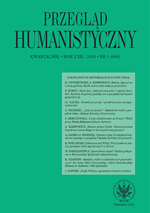Złote łany, ziemniaczane pola i zagony buraków. Roślinny krajobraz polskiej wsi w perspektywie historii gospodarczej
Golden Meadows, Potato Fields and Beet Strips. Vegetation Landscape of the Polish Village in the Perspective of Economic History
Author(s): Piotr KoryśSubject(s): History, Anthropology, Social Sciences, Cultural history, Sociology, Economic history, Social history
Published by: Wydawnictwa Uniwersytetu Warszawskiego
Keywords: Polish-Lithuanian Commonwealth; Poland; rye; wheat; oilseed rape; sugar beets; potatoes; economic history; nobility; peasants
Summary/Abstract: The article discusses the role of plants in Poland’s economic development over the last500 years. The author presents the role of five plants in the history of Poland’s development:cereals (wheat and rye), potatoes, sugar beet and rape. The specificity of the economicdevelopment of modern Europe has made Poland one of Europe’s granaries and an importantexporter of cereals. This shaped the civilization of the Polish-Lithuanian Commonwealthand contributed to its fall due to institutional specificity. In the 19th century, potatoes playedan important role in the population development of Polish lands, as they helped feed therapidly growing population. The spread of sugar beet cultivation created the conditions forthe development of modern sugar industry in the second half of the 19th century. It becameone of the first modern branches of the food industry in Poland and contributed to themodernization of the village. Quite recently, oilseed rape was to become a plant that wouldbring back the times of agricultural sheikhs – no longer the nobility would trade in cerealson the European markets, but entrepreneurs producing a vegetable substitute for diesel oil.
Journal: Przegląd Humanistyczny
- Issue Year: 460/2018
- Issue No: 1
- Page Range: 33-43
- Page Count: 11
- Language: Polish
- Content File-PDF

